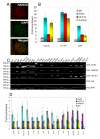Novel sequential ChIP and simplified basic ChIP protocols for promoter co-occupancy and target gene identification in human embryonic stem cells
- PMID: 19563662
- PMCID: PMC2709612
- DOI: 10.1186/1472-6750-9-59
Novel sequential ChIP and simplified basic ChIP protocols for promoter co-occupancy and target gene identification in human embryonic stem cells
Abstract
Background: The investigation of molecular mechanisms underlying transcriptional regulation, particularly in embryonic stem cells, has received increasing attention and involves the systematic identification of target genes and the analysis of promoter co-occupancy. High-throughput approaches based on chromatin immunoprecipitation (ChIP) have been widely used for this purpose. However, these approaches remain time-consuming, expensive, labor-intensive, involve multiple steps, and require complex statistical analysis. Advances in this field will greatly benefit from the development and use of simple, fast, sensitive and straightforward ChIP assay and analysis methodologies.
Results: We initially developed a simplified, basic ChIP protocol that combines simplicity, speed and sensitivity. ChIP analysis by real-time PCR was compared to analysis by densitometry with the ImageJ software. This protocol allowed the rapid identification of known target genes for SOX2, NANOG, OCT3/4, SOX17, KLF4, RUNX2, OLIG2, SMAD2/3, BMI-1, and c-MYC in a human embryonic stem cell line. We then developed a novel Sequential ChIP protocol to investigate in vivo promoter co-occupancy, which is basically characterized by the absence of antibody-antigen disruption during the assay. It combines centrifugation of agarose beads and magnetic separation. Using this Sequential ChIP protocol we found that c-MYC associates with the SOX2/NANOG/OCT3/4 complex and identified a novel RUNX2/BMI-1/SMAD2/3 complex in BG01V cells. These two TF complexes associate with two distinct sets of target genes. The RUNX2/BMI-1/SMAD2/3 complex is associated predominantly with genes not expressed in undifferentiated BG01V cells, consistent with the reported role of those TFs as transcriptional repressors.
Conclusion: These simplified basic ChIP and novel Sequential ChIP protocols were successfully tested with a variety of antibodies with human embryonic stem cells, generated a number of novel observations for future studies and might be useful for high-throughput ChIP-based assays.
Figures






References
Publication types
MeSH terms
LinkOut - more resources
Full Text Sources
Other Literature Sources
Research Materials
Miscellaneous

